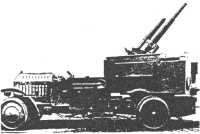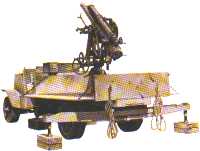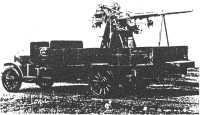The Gun - Mechanisation continuedSelf-propelled (SP) Guns for Anti-AircraftAttempts to mount guns on wheeled or tracked vehicles with built-in means of propulsion date back a century, but few met with the approval of military authorities until the decade leading up to World War 1. Most of the earlier types were designed to carry machine guns in the infantry or cavalry roles. The first SP equipments to carry ordnance were intended for action against balloons - which had been used for military observation since Napoleonic times. In 1909 the German firms of Krupp and Ehrhardt produced respectively 75- and 50-mm guns on high-angle mounts carried on the decks of commercial-type trucks modified for the purpose. Needless to say, with the rapid development of aircraft during this period, these guns were soon to be used for engaging enemy planes as well as balloons. The French followed suit by similarly mounting their Model 1897 75-mm field gun on a truck chassis. | |
 | German anti-balloon gun of 1909. |
|
Not to be outdone, the Royal Artillery at first put their 18-pr Mk 1 (3.3-in) field gun on high-angle mounting on a truck chassis. However, its performance left much to be desired so they relined the gun down to 13-pr (3-in) but retained the 18-pr cartridge. This combination proved much more efficient. It was superseded in 1914 by the QF 3-in 20-cwt gun which survived until 1946. Not another makeshift, the 3-in was a piece especially designed for the AA role, but like its predecessors it first made use of an ordinary truck body as a platform. | |
 |  |
| British 18/13-pr carried on modified motor truck. | QF 3-in 20-cwt gun on truck body. |
|
Although early designers of AA equipments found readily available truck bodies convenient for their guns, they proved too difficult to stabilise, so were soon replaced by towed platforms. WL Ruffell, 1993 previous | index | next | History index | Home | |